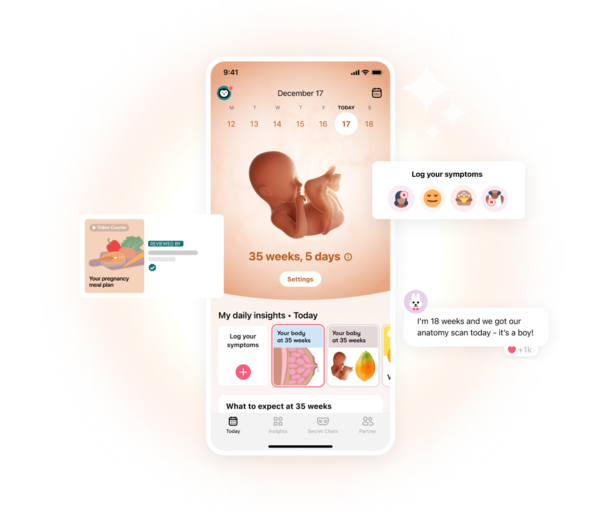The Lamaze method, which includes Lamaze breathing, is a combination of techniques designed to assist women in preparing for childbirth. Next, Flo explains how Lamaze breathing guides you through the pain and discomfort of labor.
-
Tracking cycle
-
Getting pregnant
-
Pregnancy
-
Help Center
-
Flo for Partners
-
Anonymous Mode
-
Flo app reviews
-
Flo Premium New
-
Secret Chats New
-
Symptom Checker New
-
Your cycle
-
Health 360°
-
Getting pregnant
-
Pregnancy
-
Being a mom
-
LGBTQ+
-
Quizzes
-
Ovulation calculator
-
hCG calculator
-
Pregnancy test calculator
-
Menstrual cycle calculator
-
Period calculator
-
Implantation calculator
-
Pregnancy weeks to months calculator
-
Pregnancy due date calculator
-
IVF and FET due date calculator
-
Due date calculator by ultrasound
-
Medical Affairs
-
Science & Research
-
Pass It On Project New
-
Privacy Portal
-
Press Center
-
Flo Accuracy
-
Careers
-
Contact Us
Lamaze Breathing: How It Can Help You While Giving Birth


Every piece of content at Flo Health adheres to the highest editorial standards for language, style, and medical accuracy. To learn what we do to deliver the best health and lifestyle insights to you, check out our content review principles.
Overview and history of Lamaze breathing
The Lamaze method was originally created in France in 1951 by Dr. Fernand Lamaze. It encompassed methods of breathing and relaxation, emotional support, and childbirth education classes. It was Marjorie Karmel who first introduced the Lamaze method to the U.S. In 1960, she and Elisabeth Bing co-founded the American Society for Psychoprophylaxis (ASPO), now known as Lamaze International.
Lamaze techniques quickly became very popular, as they allowed expectant parents to prepare themselves for labor. Such classes taught conscious relaxation strategies to cope with the pain of contractions.
Controlled breathing patterns also represent a fundamental part of Lamaze childbirth education. They serve as a distraction, thus reducing your brain’s perception of pain during labor. They’re thought to be most effective when used in combination with other forms of pain management.
Over the years, the focus of Lamaze classes have shifted towards the development of individualized breathing and relaxation strategies suited to each woman’s specific needs.
How can Lamaze techniques help with labor?
Nearly 70 years later, the Lamaze method is still a widely used approach for navigating women through the difficulties of labor and childbirth. But since delivery is an active process, Lamaze breathing doesn’t necessarily provide adequate comfort for everyone.
Today’s Lamaze classes show you how to find alternative sources of comfort. Newer Lamaze techniques include:
- Walking
- Rocking
- Getting massages
- Heat/cold therapy
- Hydrotherapy
- Postural changes
- Slow dancing
- Using a birth ball
These active comfort strategies are easy to learn and perform. Aside from facilitating labor, they also tackle stress and anxiety, as well as the physical pain associated with Braxton-Hicks contractions.
Naturally, Lamaze breathing isn’t a cure-all. However, they’ll allow you to remain present, focused, and able to move through contractions more easily.
Lamaze breathing techniques
Take a quiz
Find out what you can do with our Health Assistant

Although nothing takes the place of a Lamaze class taught by a certified instructor, there are certain Lamaze breathing methods you may want to begin practicing.
Slow-paced breathing
It involves inhaling slowly through your nose and exhaling through your mouth, while keeping it slightly open. Repeat throughout the entire contraction, minimizing facial movements. At the beginning and end of each breathing cycle, perform a deep, cleansing breath.
Slow-paced breathing involves inhaling slowly through your nose and exhaling through your mouth, while keeping it slightly open.
It’s important that you find a slow-paced rate that’s comfortable for you. Focus intently and release tension every time you exhale. Count to five as you inhale, and count to eight as you exhale.
Modified-paced breathing
In most cases, you’ll practice modified-paced breathing through your mouth, and it should also begin and end with a cleansing breath.
Take shallow inhalations and release short, shallow exhalations. As you exhale, make a vowel sound (e.g., “hee”), keeping your face relaxed and lips slightly open.
Keep your face relaxed and lips slightly open while practicing modified-paced breathing.
Performing modified-paced breathing too quickly can increase your oxygen consumption, so be sure to find a respiratory rate that works for you.
Patterned-paced breathing
This particular style is very similar to modified-paced breathing, but includes an extra “blow” at specific intervals. The blow is characterized by an increased inhalation-exhalation relative to the number of vowel sounds (or “hees”). The number of “hees” for each blow is either set or random.
Patterned-paced breathing includes a cleansing breath at the beginning and end of each contraction. Some examples include:
- 3:1
Do three “hees” and one blow, repeating the pattern until your contraction ends.
- 5:3:1
First, do five “hees” and one blow. Then, do three “hees” and one blow. Lastly, do one “hee” and one blow. Repeat this pattern until your contraction ends.
- Hand signals
This exercise requires a Lamaze coach or doula, who will hold up a certain number of fingers (between one and five). This indicates how many “hees” you’ll do before the blow.
Different controlled breathing patterns are recommended for each stage of labor.
Early labor
Use slow-paced breathing when you notice your contractions becoming more regular. It will aid in maintaining focus and releasing tension.
Alternatively, you could choose fast, shallow breathing in early labor if slow-paced breathing seems ineffective. Start with a cleansing breath when your contraction begins, then switch to shallow breaths. Breathe faster as your contraction intensifies, as if you’re “puffing.” Then, return to normal or slow-paced breathing.
Transitional phase
This is when your cervix goes from being dilated 8 centimeters to 10 centimeters, and it calls for a variable breathing approach. Your contractions will intensify and become more frequent.
- Take a cleansing breath as your contraction begins.
- Breathe in.
- As you exhale, do three “hees” and a longer “hoo.”
- Take another cleansing breath as your contraction ends.
Second stage of labor
Once your cervix is fully dilated, expulsive breathing encourages you to push more effectively.
- Breathe normally until you feel the urge to push.
- Take a deep, cleansing breath.
- Hold your breath or slowly release it while you push for 5 to 7 seconds.
- Exhale any air that remains in your lungs.
- Resume breathing normally until you feel the urge to push again.
Takeaway
Featuring much more than controlled breathing patterns, the Lamaze method now includes the Lamaze Six Healthy Birth Practices:
- Allow labor to begin on its own.
- Change positions by moving and walking around.
- Have a loved one or doula accompany you during childbirth.
- Avoid unnecessary medical interventions.
- Avoid giving birth while lying on your back.
- Keep your baby close by after delivery.
Ultimately, Lamaze techniques can help see you through one of the most physically demanding moments of your life. They ease the pain of contractions, boost your confidence, and move you through the stages of labor more comfortably.
You should always discuss your birth plan and personal preferences with your doctor. Just remember that sometimes, medical interventions are required to protect your health and your baby’s health during childbirth.


Hey, I'm Anique
I started using Flo app to track my period and ovulation because we wanted to have a baby.


The Flo app helped me learn about my body and spot ovulation signs during our conception journey.


I vividly
remember the day
that we switched
Flo into
Pregnancy Mode — it was
such a special
moment.
Real stories, real results
Learn how the Flo app became an amazing cheerleader for us on our conception journey.
References
History of updates
Current version (30 December 2019)
Published (30 December 2019)
In this article

Get your personal guide to pregnancy with the Flo app
-
Follow your baby's growth week by week
-
Get expert info on symptoms, safe foods, and more
-
Chat with other parents-to-be




